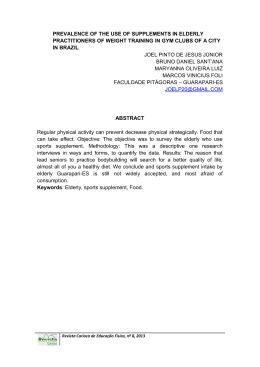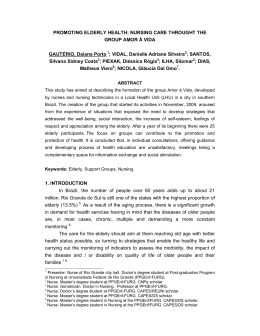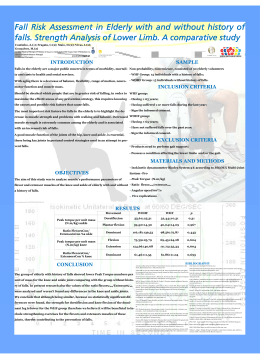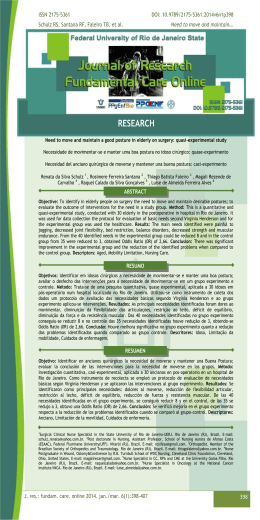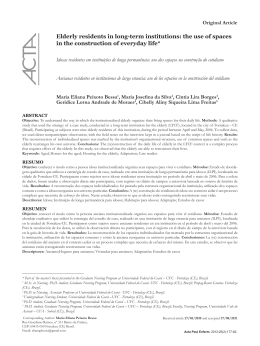International Journal of Humanities and Social Science Vol. 5, No. 6; June 2015 Brazilian Institutionalized Elderly: Profile, Self-Reported Health and Vaccination Idosos Brasileiros Institucionalizados: Perfil, Autopercepção de Saúde e Vacinação Ancianos Brasileños Institucionalizada: Perfil, Autopercepción de Salud y Vacunación Amanda da Silva Fonseca Eliana Fátima de Almeida Nascimento Natália Abou Hala Nunes University of Taubate/Department of Nursing Tiradentes Avenue, 500 Bom Conselho, 2030-180, Taubate Sao Paulo, Brazil Abstract Objetive: this study presents an analysis of the health profile, influenza immunization, and self-rated health in elderly residents in Long-Term Care Facilities (LTCF) in a city in the interior of São Paulo, Brazil. Methods: this is a descriptive cross-sectional study design. A total of 77 institutionalized elderly were interviewed dependence level I and II assessed using the Katz Scale. Data were analyzed descriptively. Results: indicate that the majority of elderly hypertension, diabetes mellitus and post-stroke sequelae and use of diaper, but without physical disabilities, with intake of more than four medications per day, institutional medical care and no previous report of fall. There was growing adherence of immunization to influenza vaccination in five years. Conclusions: to ensure a comprehensive and humane care is necessary to know the profile of the assisted population, which enables the development of strategies. Descriptors: Nursing; Vaccination; Institutionalization; Health Services for the Aged; Geriatrics Resumo Objetivo: análise do perfil de saúde, a vacinação contra influenza, e autopercepção de saúde em idosos residentes em Instituições de Longa Permanência (ILP) em uma cidade no interior de São Paulo, Brasil. Métodos: estudo descritivo transversal. Um total de 77 idosos institucionalizados foi entrevistado, com o grau de dependência I e II avaliadas pela escala Katz. Os dados foram analisados de forma descritiva. Resultados: indicam que a maioria dos idosos eram portadores de hipertensão, diabetes mellitus e pós-seqüelas de AVC e uso de fralda, mas sem deficiências físicas, com a ingestão de mais de quatro medicamentos por dia, assistência médica institucional e nenhum relatório anterior de queda. Houve crescente adesão à vacinação de imunização em cinco anos. Conclusões: para assegurar um cuidado integral e humanizado se faz necessário conhecer o perfil da população assistida, o que possibilita a elaboração de estratégias. Descritores: Enfermagem; Vacinação; Institucionalização; Serviços de Saúde para Idosos; Geriatria 84 ISSN 2220-8488 (Print), 2221-0989 (Online) ©Center for Promoting Ideas, USA www.ijhssnet.com Resumen Objetivos: análisis del perfil de salud, vacunación antigripal, y autopercepción de la salud en los ancianos residentes en instalaciones de cuidado a largo plazo (LTCF) en una ciudad del interior de São Paulo, Brasil. Métodos: estudio descriptivo transversal, El total de 77 ancianos institucionalizados se entrevistó a nivel de dependencia I y II Opinión utilizando la Escala de Katz. Los datos fueron analizados descriptivamente. Resultados: la Mayoría de la hipertensión edad avanzada, la diabetes mellitus y la post-secuelas de ictus y el uso del pañal, pero sin discapacidades físicas, con una ingesta de más de cuatro medicamentos por día, la atención médica institucional y ningún informe anterior de caída. Hay una creciente adhesión a la vacunación antigripal de la inmunización en cinco años. Conclusiones: para garantizar una atención integral y humana es necesario conocer el perfil de la población asistida, que permite el desarrollo de estrategias. Descriptores: Enfermería; Vacunación; Institucionalización; Servicios de Salud para Ancianos; Geriatría. Introduction The society has been marked by aging with a significant increase in the number of elderly, it is estimated that by the year 2050 the population will increase by about 2 million people living in developed countries. In Brazil there are around 17.6 million elderly and it is estimated that over the next 20 years this number will double. 1 Old age brings its own characteristics that may modify everyday activities, these being the social, cultural and health environment, allowing the coexistence and exchange of knowledge between individuals of the same age being important in this context.2 Long-Term Care Facilities (LTCF) for the elderly are specialized in serving this age group, elderly who have no family choose to live in institutions, because they not want to bother your family, friends, children, and thus prefer to be independent and reside in institutions. Thus, the look at the institutionalized elderly is changing, over time the institution of long permanence do not is seen as "deposit elderly", but understood and respected as an option in the context of life of each individual.3 The aging process can bring dependency, so nurses and multidisciplinary team have a crucial role to help the elderly, is a period in which the underlying disease are more pronounced. Therefore it is important that health professionals and family members are aware of the changes and can contribute to the treatment and prevention of diseases.4 This study aimed to investigate the health profile of the institutionalized elderly, vaccination and health perceived by them. Influenza is a disease that affects a large rate of elderly people, as well, the federal government established a flu shot, being a right and obligation of elderly households and institutions that harbor them. Materials and Methods This is a quantitative and cross-sectional study with a descriptive design. The study was conducted in na LTCF for elderly individuals in a city in the interior of Sao Paulo, Brazil. The participants were individuals 60 years old or older and living in an LTCF. Inclusion criteria were: being 60 years old or older, living in an LTCF, having no severe impairment of language or comprehension, degree of dependence I and II and signing a free and informed consent form. The degree of dependence was obtained by means of the Katz scale that assesses Independence in Activities of Daily Living and Instrumental Activities of Daily Living (IADL). The study was approved under protocol number 153/12 in accordance with the requirements of Resolution 196/96 preconized for research with humans.5-6 2.1 Participants Were analyzed 77 subjects who did meet the inclusion, Table 1 presents the participants characteristics, Most (50%) of the 77 institutionalized individuals were women, aged 71 to 80 years (47,50%), single (67,50%), without children (60%) with incomplete primary education (57,50), who receive a pension as a source of income (100% ), who had previous occupation as being caretakers of the house (52,50). 85 International Journal of Humanities and Social Science Vol. 5, No. 6; June 2015 Table 1: Profile of Institutionalized Elderly Individuals (N=77), Taubaté, 2012 Characteristics Gender Age (years) 45 I--- 59 60 I– 70 71 I– 80 More or equal to 81 Marital status Married Widowed Single Separated or divorced Have a Children Education Illiterate Incomplete primary school Complete primary school Incomplete secondary school Complete secondary school Complete college Source of income Retirement Other (allowance / assistance) Previous occupation to Institutionalization Caretakers of the house Worked Do not Know Female N 40 % 51,95 Male N 37 % 48,05 7 19 14 17,50 47,50 35,00 3 11 18 5 8,11 29,73 48,65 13,51 0 13 27 0 16 0 32,50 67,50 0 40,00 3 5 24 5 15 8,11 13,51 64,86 13,51 40,54 14 23 3 0 0 0 35,00 57,50 7,50 0 0 0 7 22 4 1 3 0 18,92 59,46 10,81 2,70 8,11 0 40 - 100 - 37 - 100 - 21 13 6 52,50 32,50 15,00 27 10 72,97 27,03 2.2 Data Collection Procedures Data were collected August 2012 through individual interviews with elderly individuals on the LTCF premises, Interviews were held only after the participants approved and signed the ‘‘Statement of free and informed consent’’, An instrument addressing each individuals’ name, gender, date of birth, have a children, date when admitted into the institution, source of income marital status, educational level, and previous occupation to Institutionalization, was used to characterize the elderly individuals, The ‘‘Mini Mental State Examination’’ (MMSE) was used to screen for cognitive impairment, Its score varies according to the educational level of individuals and, depending on the score, may indicate the presence of cognitive impairment, to assess the degree of dependence was used the Katz scale, which assesses Independence in Activities of Daily Living and Instrumental Activities of Daily Living (IADL), Were characterized by Grade I, independent seniors who are able to perform their activities of daily living without assistance from another person, even with the use of equipment; Grade II, dependent elderly, are able to perform daily activities such as performing self-care such as eating, walking alone, making hygiene and without any change or cognitive impairment; Grade III, the elderly who are dependent and need care in all activities of daily living and who have cognitive deficits or not. 2.3 Data Analysis Procedure Data were analyzed using analyzing the charts of institutionalized elderly and quantified in absolute numbers and percentages, analyzed quantitatively and descriptively. 86 ISSN 2220-8488 (Print), 2221-0989 (Online) ©Center for Promoting Ideas, USA www.ijhssnet.com Results Regarding the length of institutionalization most have less than three years, his going to the institution gave up due to living alone or not having someone to care, according to information in Table 2, information regarding the clinical data are shown in Table 3, which shows as co-morbidates the hypertension, diabetes and neurological disorders, diaper use, without physical alteration, daily use more than four different types of medication, with medical monitoring and judge his health as good. Table 2: Information about the Institutionalization (N = 77). Taubaté, 2012 Data Time in Institution (years) <3 3 I- 6 6 I- 9 More than 9 Reason for admission given by the Institution Lived Alone He had no one to provide care Health problems House without condition Transfer - another institution Female N % Male N % 22 7 1 10 55,00 17,50 2,50 25,00 16 5 5 11 43,24 13,51 13,51 29,73 10 14 9 0 7 25,00 35,00 22,50 0 17,50 10 16 7 4 0 27,03 43,24 18,92 10,81 0 Table 3 - Distribution of Clinical data of the Institutionalized Elderly (N = 77). Taubaté, 2012 Clinical Date Co-morbidities Hypertension Stroke sequelae Neurological changes Diabetes Mellitus Renal insufficiency Senility Cancer No apparent disease Use Of Diaper Physical changes No change Paresthesia Visual impairment / speech / walk Amputation Daily medicines (quantity) >4 3/4 Medical monitoring Clinical Other Specialties Falls Not fell There are fewer 10 year Self-perception of health status Excelent Good Bad Rubbish Do not Know Female N % Male N % 9 8 7 5 4 4 2 1 25 22.50 20.00 17.50 12.50 10.00 10.00 5.00 2.50 62.50 10 5 7 3 4 6 2 17 27.03 13.51 18.92 8.11 10.81 16.22 5.41 0 45.95 24 6 6 4 60.00 15.00 15.00 10.00 26 4 4 3 70.27 10.81 10.81 8.11 34 6 85.00 15.00 27 10 72.97 27.03 30 10 75.00 25.00 25 12 67.57 32.43 29 11 72.50 27.50 29 8 78.38 21.62 0 28 10 2 0 0 70.00 25.00 5 0 1 28 2 2 4 2.70 75.68 5.41 5.41 10.81 There was a progressive increase in the vaccination against influenza both among women as among men as shown in Table 4. 87 International Journal of Humanities and Social Science Vol. 5, No. 6; June 2015 Table 4 - Distribution of Influenza Immunization of Institutionalized Elderly. Taubaté, 2012 Gender Female Male 2008 N 30 25 % 75.00 67.57 2009 N 28 25 % 70.00 67.57 2010 N 28 28 % 70.00 75.68 2011 N 35 29 % 87.50 78.38 2012 N 40 34 % 100 91.89 Discussion Being in a Long-Term Care Facility (CTCF) for some people no is longer the punishment and even negligence. Today many seniors believe that to be in an institution results in better care, adequate infrastructure and daily activities targeted to your needs.7-8 It is important to remember that despite the divergence of studies and concepts when the LTCF, after a certain period the feeling before negative becomes positive, because of security and satisfaction with social life got in the institution.9 The increased life expectancy among women is evident in developing countries like Brazil, due low fertility rates and high male mortality rates, and the women show more attention to health, know more signs and symptoms of diseases and seek more health professionals when compared to men.10 Along with the aforementioned characteristics, this and other studies show that single elderly women with low education which possibly had no children and whose family is less numerous, is more likely to age in LTCF, because there is lack of potential caregivers.8 It is noteworthy in educational terms that illiteracy is a reality in developing countries like Brazil. In this study the elderly lived in a time where education was not a priority, which serves as a warning to professional caregivers in terms of proper communication to the level of education and understanding that the elderly care may have.7 The population aging, sedentary lifestyle, inadequate dietary habits, and other social changes and behavior, increase the incidence and prevalence of diabetes and hypertension, and the mortality for disease. The bad habits culminate in stroke debilitating and limit neurologically.11 Thus, because of the senescence the older more becomes dependent on daily medications which require a closer look at for is not be exchanged or given in inappropriate times. The large drug intake in the elderly becomes well assisted in LTCF which have professionals for this type of assistance. However, one must consider that independence and self-care should be encouraged in the institutions so that they do not serve as allies of the decrease of autonomy of activities of daily living of the elderly.12 As in this study, the institutionalized elderly has shown a good health perception. It proves able to realize self and evaluate your health which demonstrates lucidity and insight, which can often be overlooked and ignored by professional caregivers. Therefore, one should take into account the self-assessment referred to by the elderly and use it as a tool in health interventions. The individual who presents changes resulting from aging process has a decline in immune activity, making the elderly vulnerable to disease, and the main circulatory and respiratory system, cancers and certain infectious and parasitic diseases.2,13 The influenza virus is one of the causes of respiratory infections in the elderly, where 75% of infections are caused by it, vaccination is an effective prevention method, which gets good results in this regard. Because it influences the reduction of mortality from influenza, hospitalization, use of drugs and prophylaxis secondary diseases.14-16 Vaccination in hospital and in the LTCF for elderly were able to reach a large number of elderly people over the years, so reducing the risk of developing severe respiratory diseases that can lead to death.17-20 Conclusions Studies like this allow to perceive the institutionalized elderly as a possibility within the assistance that must be looked with cautiously. It is worth noting that if the elder has not a good family socializing, this will inevitably contribute to the absence of this interaction in old age. 88 ISSN 2220-8488 (Print), 2221-0989 (Online) ©Center for Promoting Ideas, USA www.ijhssnet.com Even LTCF being places able to assist the elderly with quality, the family environment whenever possible should be encouraged and cozier option at this stage of life. Conflict of Interest Statement There are no financial conflicts of interest or of any other nature, on the part of the authors ‘‘Brazilian institutionalized elderly: Profile, self-reported health and vaccination’’. References Instituto Brasileiro de Geografia e Estatística. IBGE. Dados epidemiológicos sobre o envelhecimento. Rio de Janeiro;2010. Pickard S.Frail bodies: geriatric medicine and the constitution of the fourth age. Sociol Health Illn. 2014 may;36(4):549-63. Leite SC, Marques IR. Sentimentos de idosos ao serem internados em instituição de longa permanência. Revista de Enfermagem UNISA. 2011;12(1):31-7. Moreira MDM. O envelhecimento da população brasileira: intensidade, feminização e dependência. Rev. Bras. Estud. Popul. 2014; 15(1):79-94. Smanioto FN, Haddad MCFL. Índice de Katz aplicado a idosos institucionalizados. Rev RENE. 2011 jan/mar;12(1):18-23. Ministério da Saúde (BR). Conselho Nacional de Saúde. Resolução 196, de 10 de outubro de 1996: diretrizes e normas regulamentadoras de pesquisa envolvendo seres humanos. Brasília; 1996. Davim RMB, Torres DV, Dantas SMM, Lima VM. Estudo com idosos de instituições asilares no município de Natal/RN: características socioeconômicas e de saúde. Rev. Latino-Am. Enfermagem. 2004;12(3):518-24. Silva ME, Cristianismo RS, Dutra RL, Dutra IR. Revista de Enfermagem do Centro-Oeste Mineiro. 2013 jan/abr;3(1):569-76. Malheiro AD. O processo de institucionalização de idosos em Porto Alegre – RS / [dissertação]. Porto Alegre (RS): Pontifícia Universidade Católica do Rio Grande do Sul – PUC, 2012. Ferreira Z. Percepção do estado de saúde da pessoa idosa institucionalizada. [dissertação]. Rio de Janeiro (RJ): Universidade Nova de Lisboa, 2011. Nogueira IC, Santos ZMSA, Mont’Alverne DGB, Martins ABT, Magalhães CBA. Efeitos do exercício físico no controle da hipertensão arterial em idosos: uma revisão sistemática. Rev. bras. geriatr. gerontol. 2012;15(3):587-601. Ministério da Saúde (BR). Caderno de Atenção Básica, envelhecimento e saúde da pessoa idosa nº 19. [internet]. [acesso em 2015 fev 23]. Disponível em http://dab.saude.gov.br/docs/publicacoes/cadernos_ab/abcad19.pdf Soares MM, Leão LOL, Dias CA, Rodrigues SM, Machado CJ. Adesão do idoso ao tratamento da hipertensão arterial sistêmica: revisão integrativa. Cogitare enferm. 2012 jan/mar;17(1):144-50. Alencar MA, Bruck NNS, Pereira BC, Câmara TMM, Almeida RDS. Perfil dos idosos residentes em uma instituição de longa permanência. Rev. bras. geriatr. gerontol. 2012;15(4):785-96. Ministério da Saúde (BR). Informe Técnico Campanha Nacional de Vacinação contra a Influenza. [Internet]. [acesso em 2011 out 03. Disponível em http://portal.saude.gov.br/portal/arquivos/pdf/informe_campanha_influenza_2011.pdf Donalisio MR, Francisco PMSB, Latorre MRDO. Tendência da mortalidade por doenças respiratórias em idosos antes e depois das campanhas de vacinação contra influenza no Estado de São Paulo: 1980 a 2004. Rev bras epidemiol. 2006;9(1);32-41. Francisco PMSB, Donalisio MR, Barros MDBA, César SLAG, Carandina L, Goldbaum M. Fatores associados à vacinação contra a influenza em idosos. Rev Panam salud publica. 2006;19(4):259-64. Reed C et al. Estimated influenza illnesses and hospitalizations averted by vaccination--United States, 2013-14 influenza season. Mor. mortal. wkly rep. CDC surveill. summ. 2014 Dec 12;63(49):1151-4. Thomas RE1, Lorenzetti DL. Interventions to increase influenza vaccination rates of those 60 years and older in the community. Cochrane Database Syst Rev. 2014 Jul 7;7:CD005188. Riedmann EM. Influenza vaccines prevented over 6 million flu cases in the US. Hum Vaccin Immunother. 2014;10(2):253. 89
Download
